

Directives and Policies - ISO, International Organization for Standardization. 80856e21-1bf7-49eb-b2a8-c2a60e1e82d0.pdf. CENELEC - About CENELEC - What we stand for - Support legislation. Regulatory framework for electronic communications. The “Framework Directive” forms part of the “Telecommunications Package” designed to recast the existing regulatory framework for telecommunications in order to make the electronic communications sector more competitive.
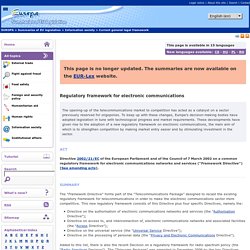
This new regulatory framework consists of this Directive plus four specific Directives, namely the: Directive on the authorisation of electronic communications networks and services (the “Authorisation Directive”); Directive on access to, and interconnection of, electronic communications networks and associated facilities (the “Access Directive”); Directive on the universal service (the “Universal Service Directive”); Directive on the processing of personal data (the “Privacy and Electronic Communications Directive”). Added to this list, there is also the recent Decision on a regulatory framework for radio spectrum policy (the “Radio Spectrum Decision”). Scope, aim and definitions National regulatory authorities Independence. Data_Privacy_Directive.pdf. RoHSGuidance2006.pdf. U.S. Conformity Assessment System: 3rd Party Conformity Assessment.
Third-party conformity assessment approaches used in the United States include: Third-party Testing Third-party testing may occur at the end of the design or production cycle, whereby an independent testing laboratory takes the necessary steps to determine that one or more characteristics of an object comply with the appropriate technical standards and requirements.
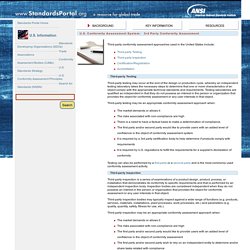
Testing laboratories are qualified as independent in that they do not possess an interest in the person or organization that provides the object for conformity assessment or any user interests in that object. Third-party testing may be an appropriate conformity assessment approach when: Third-party Inspection Third-party inspection is a series of examinations of a product design, product, process, or installation that demonstrates its conformity to specific requirements and that is performed by an independent inspection body. Third-party inspection may be an appropriate conformity assessment approach when: Accreditation. U.S. Conformity Assessment System: 3rd Party Conformity Assessment. RoHS Compliance Guide: Regulations, 6 Substances, Exemptions, WEEE. Restriction on use of hazardous substances - RoHS.
Skip to main content HomeNews & eventsVideosEPA mapsFAQSite mapContact us You are here: Home > Enforcement > Restriction on use of hazardous substances - RoHS Restriction on use of hazardous substances - RoHS With more and more electrical and electronic items becoming available, coupled with the shorter life cycles of these products, it is critical that these products are produced with minimum risk to human health and the environment.
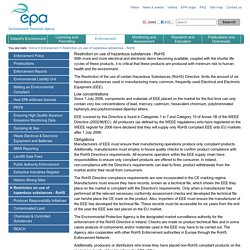
The Restriction of the use of certain Hazardous Substances (RoHS) Directive limits the amount of six hazardous substances used in manufacturing many common, frequently used Electrical and Electronic Equipment (EEE). Low concentrations Since 1 July 2006, components and materials of EEE placed on the market for the first time can only contain very low concentrations of lead, mercury, cadmium, hexavalent chromium, polybrominated biphenyls and polybrominated dipenhyl ethers. Obligations Learn more. B2B_EEE_producer.pdf. Industry Specification Groups. Definition Industry Specification Groups exist alongside the current Technical Organization supplementing the existing standards development process.
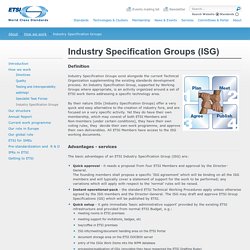
An Industry Specification Group, supported by Working Groups where appropriate, is an activity organized around a set of ETSI work items addressing a specific technology area. By their nature ISGs (Industry Specification Groups) offer a very quick and easy alternative to the creation of industry fora, and are focused on a very specific activity. Yet they do have their own membership, which may consist of both ETSI Members and Non-members (under certain conditions), they have their own voting rules, they decide their own work programme, and approve their own deliverables.
All ETSI Members have access to the ISG working documents. m493.pdf. ETSI - European Telecommunications Standards Institute. ISO_IEC_Directives_Part_1_and_Consolidated_ISO_Supplement_%2D_2014_%285th_edition%29_%2D_PDF.pdf. Hpweeecompliance.pdf. Disassembly_person_2008313151150.pdf. Standards organization. A standards organization, standards body, standards developing organization (SDO), or standards setting organization (SSO) is any organization whose primary activities are developing, coordinating, promulgating, revising, amending, reissuing, interpreting, or otherwise producing technical standards that are intended to address the needs of some relatively wide base of affected adopters.

Most standards are voluntary in the sense that they are offered for adoption by people or industry without being mandated in law. Some standards become mandatory when they are adopted by regulators as legal requirements in particular domains. The term formal standard refers specifically to a specification that has been approved by a standards setting organization. The term de jure standard refers to a standard mandated by legal requirements or refers generally to any formal standard. History[edit] Standardization[edit]
Press release: WEEELABEX. Standards that will take the WEEE management business to the next level. 14 October 2013 In the past four years, the WEEE Forum, an EU grouping associating 39 producer compliance schemes, developed proprietary standards in coalition with recyclers and producers.

CENELEC, a European standards body, is now translating the standards into official EN standards. The standards will affect all parties collecting, handling or processing e-waste. The standards will affect all undertakings with which the twenty-six producer compliance schemes (‘WEEELABEX systems’) of the newly created, Prague-based WEEELABEX organisation have a contractual relationship. CENELEC - About CENELEC - What we stand for - Support legislation. More than twenty years ago, the New Approach enabled the different European Standards Organizations (ESOs) to take part in the legislative make-up.
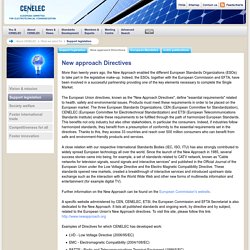
Indeed, the ESOs, together with the European Commission and EFTA, have been involved in a successful partnership providing one of the key elements necessary to complete the Single Market. The European Union directives, known as the "New Approach Directives", define "essential requirements" related to health, safety and environmental issues. Products must meet these requirements in order to be placed on the European market. The three European Standards Organizations, CEN (European Committee for Standardization), CENELEC (European Committee for Electrotechnical Standardization) and ETSI (European Telecommunications Standards Institute) enable these requirements to be fulfilled through the path of harmonized European Standards.
This benefits not only industry but also other stakeholders, in particular the consumers. EU Directive 95-46-EC - Chapter 1 - Data Protection Commissioner - Ireland. EU Directive 95/46/EC - The Data Protection Directive Article 1 Object of the Directive 1.
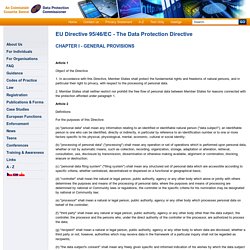
In accordance with this Directive, Member States shall protect the fundamental rights and freedoms of natural persons, and in particular their right to privacy, with respect to the processing of personal data. 2. Waste Electrical and Electronic Equipment Directive. The Waste Electrical and Electronic Equipment Directive (WEEE Directive) is the European Community directive 2012/19/EU on waste electrical and electronic equipment (WEEE) which, together with the RoHS Directive 2002/95/EC, became European Law in February 2003.
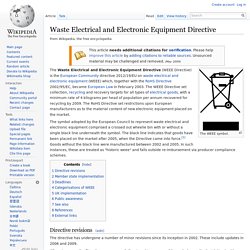
The WEEE Directive set collection, recycling and recovery targets for all types of electrical goods, with a minimum rate of 4 kilograms per head of population per annum recovered for recycling by 2009. Data protection in the electronic communications sector. Recast of the WEEE Directive - Environment. Additional tools Waste of electrical and electronic equipment (WEEE) such as computers, TV-sets, fridges and cell phones is one the fastest growing waste streams in the EU, with some 9 million tonnes generated in 2005, and expected to grow to more than 12 million tonnes by 2020.

WEEE is a complex mixture of materials and components that because of their hazardous content, and if not properly managed, can cause major environmental and health problems. Moreover, the production of modern electronics requires the use of scarce and expensive resources (e.g. around 10% of total gold worldwide is used for their production). Resource.html.
Recast of the WEEE Directive - Environment. 32002L0096. 32002L0096. WEEE directive. Scope 1. The WEEE Directive shall apply to electrical and electronic equipment falling under the categories set out in Annex IA provided that the equipment concerned is not part of another type of equipment that does not fall within the scope of this Directive. Annex IB contains a list of products which fall under the categories set out in Annex IA. 2. This Directive shall apply without prejudice to Community legislation on safety and health requirements and specific Community waste management legislation. 3.